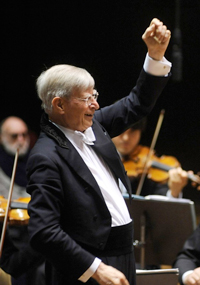by Daniel Hathaway

Berwald’s four symphonies, written between 1842 and 1845, bear curious nicknames: the 3rd is subtitled Sinfonie singulière (unique), the others sérieuse, capricieuse, and naïve. The composer seems to have been a real character, having at various times in his parallel business career worked in an orthopaedic institute, managed a glassworks, run a sawmill, and manufactured bricks.
The third symphony sounds fresh and imaginative throughout its non-standard three movements. Berwald uses his musical motives like Lego blocks to construct longer themes, playing with melodic sequences that often seem to stack up just one level too high. The fabric of the symphony is continuously interrupted by impertinent gestures from woodwinds or strings — little swirls of non sequiturs. The most prominent interruption comes in the middle of the Adagio, when a sudden bam! from the timpani initiates a scherzo as though a starter’s gun has set runners off on a race. The timpani prominently return in the finale to send a wind chorale fleeing for its life.
Berwald’s third left a positive impression, far more cheerful and ingratiating than the composer’s own personality, judging from his biography in the program book. As an absolute coincidence, the first and only time The Cleveland Orchestra performed the work before this weekend was in 1972 under the baton of the late Louis Lane, who died earlier in the week. It made a nice memorial to the long-time Cleveland Orchestra resident conductor.
Dvořák’s seventh symphony is thought by many to be his most mature work in the genre. Influenced not a little by Johannes Brahms, who had recently played movements from his third symphony on the piano for Dvořák, the piece has a Germanic solidity and gravitas that contrasts with the composer’s more Bohemian-styled works. Only the third-movement scherzo truly invokes Dvořák’s Bohemian roots.
Blomstedt has forged a long and deep friendship with the Cleveland Orchestra musicians, and both symphonies demonstrated that conductor and musicians trust one another implicitly. Conducting with a score on the music stand but never opening it, Blomstedt molded and shaped this evening’s works with the subtlest of gestures, many of them sharp as the releasing of a coiled spring and meant to point up accents or important entrances. Except for a few isolated moments, the ensemble was precise. Dvořák’s sonorities, from the subdued to the triumphant, were warm and beautifully layered.
After the Berwald, Herbert Blomstedt shook hands all the way around the first desks of strings. After the Dvořák, he waded deep into the orchestra to invite soloists and sections to stand.
A few callbacks later, three percussionists suddenly swept onstage and Blomstedt and the Orchestra dazzled the crowd with a brilliant performance of Dvořák’s Slavonic Dance No. 8 from Op. 46. It’s a Cleveland Orchestra standard, and was a favorite of George Szell. Though “encores” are rare at Severance Hall, this one capped off the evening splendidly.
Published on ClevelandClassical.com February 29, 2016.
Click here for a printable copy of this article


